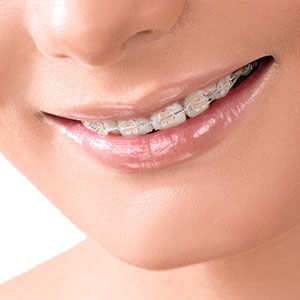Now that you have your braces, it is really important to maintain a good oral hygiene regimen throughout the length of your treatment. Braces, wires, bands and retainers can all trap food and make it difficult to brush or floss away plaque. Careful brushing and flossing, preferably after every meal and snack, is the best way to prevent plaque build-up, tooth decay and gum disease.
Step1: Start with the outside of the teeth, with the brush at straight angle. Use circular, vibrating motions.
Step2: Clean the area between the gums and braces by angling the brush as necessary. Keep moving in a small circular motion.
Step3: Clean the rest of the outside of the teeth by angling the brush up (down for the lower jaw).
Step4: Carefully brush the chewing surface of both the upper and lower jaw.
Step5: Finish by brushing the inside of the teeth.
Step1: Floss at least once a day. The floss needs to be pulled under the archwire. A floss threader facilitates this. Start by pulling floss through the threader.
Step2: Push the end of the floss threader under the arch wire and pull the floss through.
Step3: Pull the floss up between the teeth and gently move it up and down the side of both teeth. Remember to move it up all the way under the gums.
Step4: Pull the floss out and use a different section of it for the next tooth.
When you are finished brushing and flossing, rinse your mouth carefully with water. Then use a fluoride containing mouth rinse according to the manufacturers’ directions. This is important in preventing decalcification, the unsightly white scars in the enamel around your braces, which are permanent and can lead to dental decay. If canker sores, minor wounds and other mouth and gum irritations occur, an antiseptic mouth rinse can help reduce inflammation and provide relief, enabling natural healing to occur.
An interdental toothbrush (Proxabrush®) is another aid you might find useful in keeping your teeth, braces and gums clean and healthy. It can be used to clean under orthodontic wires and around braces. Use this device slowly and carefully, so you do not damage your braces.
During the retention phase, it is important to brush your retainers every time you brush your teeth as they can accumulate food particles and plaque.
Once a day, you should soak your appliance in a glass of room-temperature tap water with a denture-cleaning tablet, such as Polident® or Efferent®. This will help prevent plaque build-up and oral infections and will keep your appliance tasting better. DO NOT use hot water as it can distort the appliance.
Your teeth may be a little sore for the first week in braces, so we recommend sticking to a soft food diet until the discomfort subsides. While in braces, you can still eat just about anything although there are a few exceptions.
You should avoid hard foods, such as ice, corn nuts and hard crusts of bread or pizza, as well as sticky foods, including taffy and caramels. These foods can damage wires and brackets. It is also important to minimize foods high in sugar content, like candy and cookies, and reduce soda consumption to once a day.

Metal braces are the most common type. They are made of high-grade stainless steel. Today’s metal braces are smaller, more comfortable and more attractive.

The Invisalign System is a series of clear overlay templates—called aligners—that have been generated by computer simulation to gradually move the teeth. This system is available to teen and adult patients with certain orthodontic bite problems.

Ceramic braces are made of translucent (clear) material. They are most popular with adult patients, due to their cosmetic appeal. The only drawback to ceramic brackets is that they are more fragile, and the elastic ties can discolor between orthodontic visits.
When a person’s teeth or jaw structure do not fit together properly, orthodontic treatment may be necessary to straighten teeth and promote ideal function. These problems, often referred to as malocclusions (or bad bites), can cause speech difficulty, premature wear of teeth’s protective enamel and even increase the rate of breakdown of the bone and gums that support the teeth.